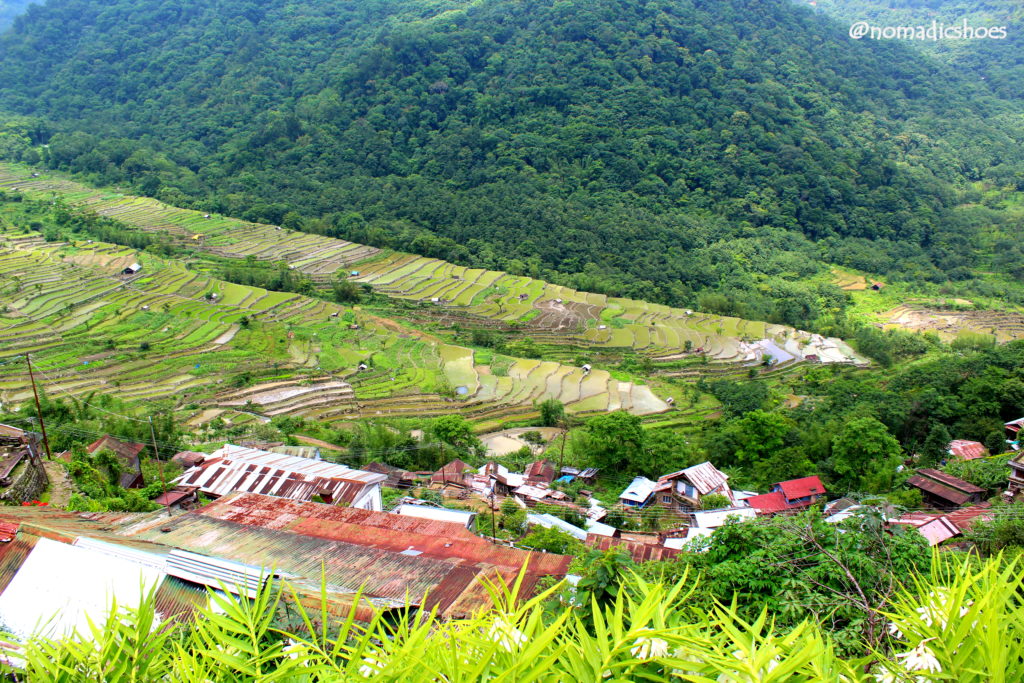Blessed with rich flora and fauna, Khonoma is a beautiful settlement of Angami-Nagas, an indigenous warrior tribe of Nagaland. 20 km from Kohima, this quaint village in Dzokou Valley is a forerunner in changing the game in environmental preservation practices.
One will surely be surprised to see how age old traditions & way of life co-exist with a fast influencing western culture. So has the tribal belief system, influenced by Christianity. While at it, savour the traditional cuisine [if you can bear the smell of bamboo shoots], hike down to the terraced farmlands, sit with village elders and listen to the stories of this warrior-clan.
Tourism is really slow in Nagaland, not many venture out to this conflict prone part of North-East India. It is only around the Hornbill Festival that the state is prepared like a new bride, and that is a blessing in disguise for the travellers like me – who travel far in search of nature & everything natural and less exploited.
If you are planning to visit Nagaland or any of the other seven sister states, my blog – Ten things to pack for North-East Trip will surely help you.
A little on the history of Khonoma from the British era.
Anglo-Naga Battle
Tired of the Angami incursions in the plains of Assam and also in hopes of finding a direct route to Manipur from Assam, British officials started seizing villages in the Naga hills. The warriors of Khonoma displayed their valour and resisted the British army at every point. The first Anglo-Naga battle took place in 1850 and lasted for less than a day in which the Angamis successfully saved their village from the Britishers.
The second Anglo-Naga battle was against conversion to Christianity and dislike towards the British way of life. After a lot of political drama, it was decided by the then government to appease the Nagas in order to control the situation.
Burial System
One of the unique things that I saw here was the location of the graves. Khonoma people bury their loved ones just outside their homes. Keep them close, even in death, is what they believe in. Most of the houses here have a grave in their gardens and they are decorated with artificial floral arrangements.
Environment Conservation
Though a predominately hunting tribe, Khonoma has come a long way to become an eco-village. In 1998, in order to protect the environment, the village council established the Khonoma Nature Conservation and Tragopan Sanctuary which covers an estimated area of 75 square kilometres. Over the last two decade, there has been a decline in deforestation and poaching. Hunting and logging are completely banned from the area to save the endangered Blyth`s Tragopan.
How to reach:
- Local bus from Kohima – If you have enough time at your hand and want to save money, then taking a bus is a good idea. The service is really bad, confirm a day before about its departure.
- Hire a cab – Much reliable and faster way to reach. It will cost you aroundRs. 2000-3000 for a day`s trip. You can contact Sonu at 09077340229. He drove us around Kohima, he is reliable and good at heart.
You might also want to read:
Best time to visit:
May to September
Guide:
You can contact Mr Khate at 08575217214, he can navigate you through the village lanes while narrating Khonoma`s history. He can also arrange a homestay, if you want to spend a night there in the village.
So, if you are going to North-East India, then make some time for Nagaland. The media does give an exaggerated picture of the insurgency situation here, but trust me it’s safe to travel here. Just make sure you confirm everything thrice, from hotel bookings to cab fares, from bus timings to route to a specific place. Reconfirm and re-confirm for your own good.
Happy travelling!!! 🙂

